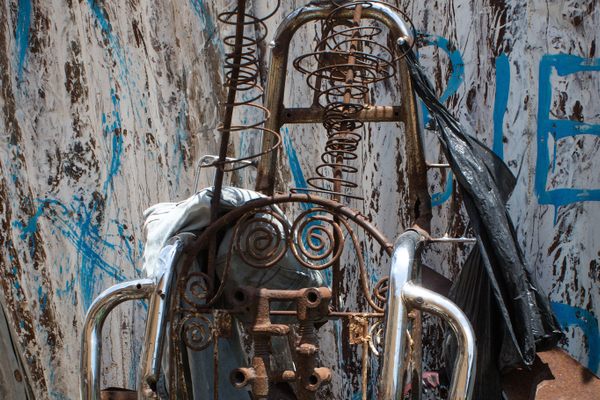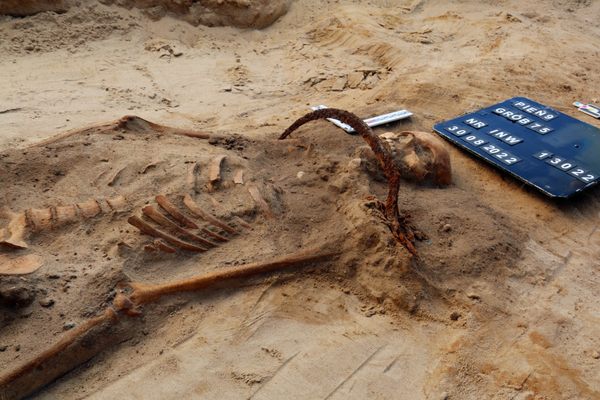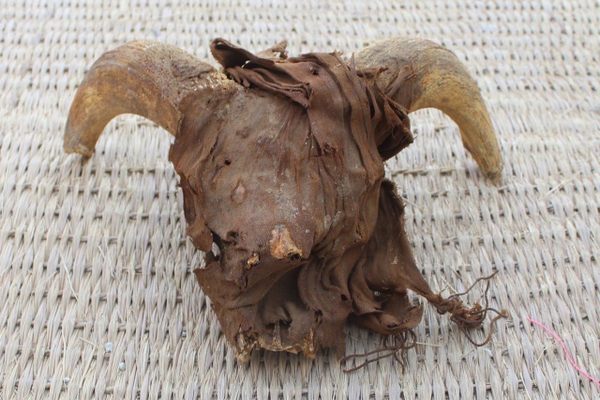The Modern and Macabre Vodou of Haiti
On January 12, 2010, Haiti was struck by an earthquake of catastrophic proportions. The death toll was estimated to be in the hundreds of thousands, while many survivors were left without food, shelter, or access to clean water. For a country that was already ranked as the poorest in the Western hemisphere, this devastating display of nature’s destructive power could not have felt less deserved.
Haitian ghettos (photograph by Darmon Richter, via The Bohemian Blog)
The ruined cathedral of Port-au-Prince (photograph by Darmon Richter, via The Bohemian Blog)
It is often out of despair and desperation that people search most earnestly for meaning; from a position of having nothing, that they more readily open themselves up to supernatural guidance. In the wake of the earthquake, many Haitians were rallied towards either one or the other of this nation’s main religions: Christianity and Vodou.
Christianity is widespread in Haiti, its scriptures often emblazoned in bold, colorful lettering across the front of shops, trucks, markets and homes. Hand-painted billboards in the capital, Port-au-Prince, bear slogans such as “School of Mary & Joseph,” “Christ-is-Kind Pharmacy,” or even “Jesus Saves Bakery.
Some Christians here believe that the quake was caused by Vodou, that God sent targeted shockwaves through the earth in order to punish the heretics, and put an end to this false — and dangerous — religion. For all its critics though, the traditional practice of Vodou still thrives in Haiti.
You won’t see it out in the open. It is secretive and subversive, an age-old ceremony that has been pushed further underground by the recent media focus on the country. As a tourist in Haiti, you’ll likely just see traces of Vodou, the ephemera of faith. Visit the noisy, chaotic “Marchéde Fer” — the old iron market of Port-au-Prince — and you’ll find vendors selling herbs and voodoo dolls, market stalls full of curious trinkets and esoteric carvings.
Flooding in Port-au-Prince (photograph by Darmon Richter, via The Bohemian Blog)
A street in Port-au-Prince (photograph by Darmon Richter, via The Bohemian Blog)
For a fee, they’ll even put on a show. Tour groups are sometimes invited to attend “authentic” Vodou ceremonies, giving roughly a month’s local salary to see a man dance, sing, and light candles. You’ll pay to see him wave his magic wand, and mumble incoherent phrases in French Creole. You’ll need to pay for the offerings, too, and the loa (powerful Vodou spirits) will settle for nothing less than a bottle of the finest rum. Cigars, too, are generally welcome. Some days the veil between worlds is heavier than on others… it might take another cash offering to help entice the spirits through.
By the end, you’ll have spent a hundred bucks and seen nothing of any real significance.
But that’s not real Vodou. To experience anything authentic, you’ll need to dig a little deeper. The Christian camp is often embarrassed to bring you nearer the truth, while for the believers this is too deep, too personal a thing to share for spectacle. If you want to see real Haitian Vodou, you’re going to have to find it for yourself.
On Boulevard Jn J Dessalines in Port-au-Prince, there’s a kind of outdoor gallery, a collection of graphic work by local sculptors and artists. The signs and sigils of practical Vodou feature heavily; hand-painted veve appear alongside masonic and new-world-order symbology, and decorate a disturbing range of sculptures formed from children’s dolls and industrial debris, hand-carved wood and human bones.
It’s not until you’ve seen a freshly exhumed human skull attached to the end of a vacuum cleaner and painted up with the sigils of a voodoo god, that you’re anywhere close to understanding the strange blend of macabre tradition and failed industrialization that inhabits the urban sprawl at the heart of Haiti’s capital.
Entrance to the “Atis Rezistans” art museum (photograph by Darmon Richter, via The Bohemian Blog)
Vodou characters in a Haitian art museum (photograph by Darmon Richter, via The Bohemian Blog)
Human bones & old car parts (photograph by Darmon Richter, via The Bohemian Blog)
Children’s dolls & human skulls (photograph by Darmon Richter, via The Bohemian Blog)
For the record, this still isn’t Vodou you’re looking at — but you’re definitely getting warmer. If it’s full immersion you’re after though, an authentic encounter with the Vodou faith, then your next stop should be the capital’s chief burial ground: Le Grand Cimetière.
Vodou is more than just philosophy — it is practice. It is hands-on, and it is dirty. The bones of the dead, the earthly remains of ancestors, take on a very special significance in the Vodou faith, and so it should come as no wonder that the necropolis at the center of the capital serves as Vodou ground zero.
After the earthquake, an estimated 250,000 residential houses in Port-au-Prince were left in ruin. That’s a lot of people without homes. The capital’s Grand Cemetery — opened at the turn of the 19th century and consisting of tens of thousands of tombs and mausoleums — suddenly became a place of refuge for the destitute. Ancestors rolled over to share their roofs, their coffins, as the city’s poorest flooded through the cemetery gates in search of sanctuary.
Entrance to the Grand Cemetery (photograph by Darmon Richter, via The Bohemian Blog)
Vodou dolls pinned to a tree in the cemetery (photograph by Darmon Richter, via The Bohemian Blog)
They broke open tombs, this new wave of grave-dwellers. Many of the interred bodies were cast out into the alleyways of the necropolis, and burnt, some with, some without ritual. A whole new community grew up inside and in between the old stone monuments. In the far back corner of the Grand Cemetery, beneath the mountain slopes where tents stand amidst tumbling mounds of rubble, the citizens of the necropolis have raised a ramshackle church. The congregation moans and wails through the simple ceremonies, as the canvas awning flaps noisily in the wind.
Outside the church, a jet-black cross stands alone in a courtyard, hemmed in by mausoleums, marble walls. It is a shrine to Baron Samedi: ruler of the Vodou underworld, and lord of the death loa, or “guédé.” Le Baron typically appears dressed in funerary attire, with a black top hat and a skull for a face. In the Grand Cimetière, worshippers leave offerings for him at this shrine; they write messages in blood across the walls that surround it.
Worshippers at a shrine to Baron Samedi (photograph by Darmon Richter, via The Bohemian Blog)
Mural in a Haitian cemetery (photograph by Darmon Richter, via The Bohemian Blog)
A shrine to Baron Kriminel (photograph by Darmon Richter, via The Bohemian Blog)
Not far away, in a quiet corner of the necropolis stands another shrine. This one is to the fearsome guédé known as Baron Kriminel. While Samedi may be seen as the master of the veils and the newly dead, Baron Kriminel is a manifestation of pure malice and violence. In the Vodou tradition he is sometimes known as the first murderer; a possible parallel to the biblical Cain. When summoned in ceremony, Baron Kriminel rides his host into a frenzy, causing them to bite and spit and slash and claw at those around them.
If any proof were needed that these shrines see active use — that Vodou today is more than simply monuments and writing on the walls — then it can be found all around this cemetery. Human bones and skulls appear nailed to the trunks of trees; Vodou dolls and votives are prolific in number, decorating tombs and branches and monuments; and of the goats that wander freely throughout the cemetery, some can be seen laying in the shadows between tombs, their throats cut deep from one side to the other.
Vodou dolls & human skulls (photograph by Darmon Richter, via The Bohemian Blog)
Haitian tombs (photograph by Darmon Richter, via The Bohemian Blog)
On the subject of sacrifice, it is not only animals that are offered up to the loa in modern-day ritual. At Léogâne — a town right at the epicenter of the 2010 earthquake — there stands a remote orphanage run by Christian missionaries. Many of the children here were born with deformities, and some still bear the scars of Vodou ritual.
According to traditional Vodou beliefs, children brought into the world with birth defects are thusly marked out as daemonic vessels, and to protect the community, such children must be offered up as sacrifice to the loa. One boy at the orphanage, a quadriplegic, was smuggled out of his mountain village and carried to safety here, after his mother had handed him over to the local Vodou priests. Another child, a girl, has thick, angry scars across her neck; she was rescued after her throat was slashed in ritual, and her body — still alive — thrown out onto a rubbish pile.
That’s the way the Christians tell it, at least.
The rooftops of Port-au-Prince (photograph by Darmon Richter, via The Bohemian Blog)
One of the Grand Cemetery’s resident goats (photograph by Darmon Richter, via The Bohemian Blog)
Despite the underlying dichotomy, despite this invisible battle of minds that rages at the heart of Haitian culture, the people themselves are — for the most part — kind and welcoming and hospitable. For every baby-killing priest you hear about, there must be at least a thousand decent human beings who peacefully adhere to the teachings of this nation’s Vodou faith.
No religion should be judged purely on its most radical members. Christianity today is not the Salem Witch Trials. Islam is not Al Qaeda. Vodou, at its most bloody, is a truly terrifying spectacle — and yet the philosophy that surrounds it, the finely structured explanations of life and death, of the material and immaterial planes, is more complex, more thoughtful, and more intrinsic to Haitian culture than many would give it credit for.
Darmon Richter is a freelance writer, musician and photographer. You can find more of his explorations of the bizarre, secret, and macabre at the Bohemian Blog.































Follow us on Twitter to get the latest on the world's hidden wonders.
Like us on Facebook to get the latest on the world's hidden wonders.
Follow us on Twitter Like us on Facebook